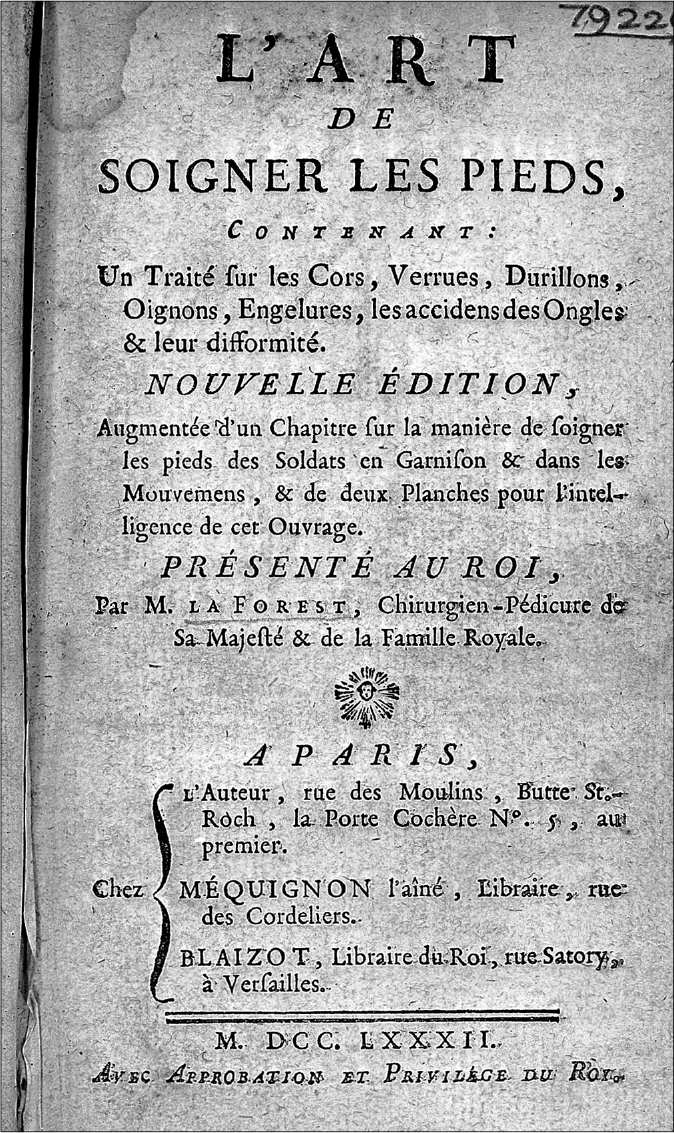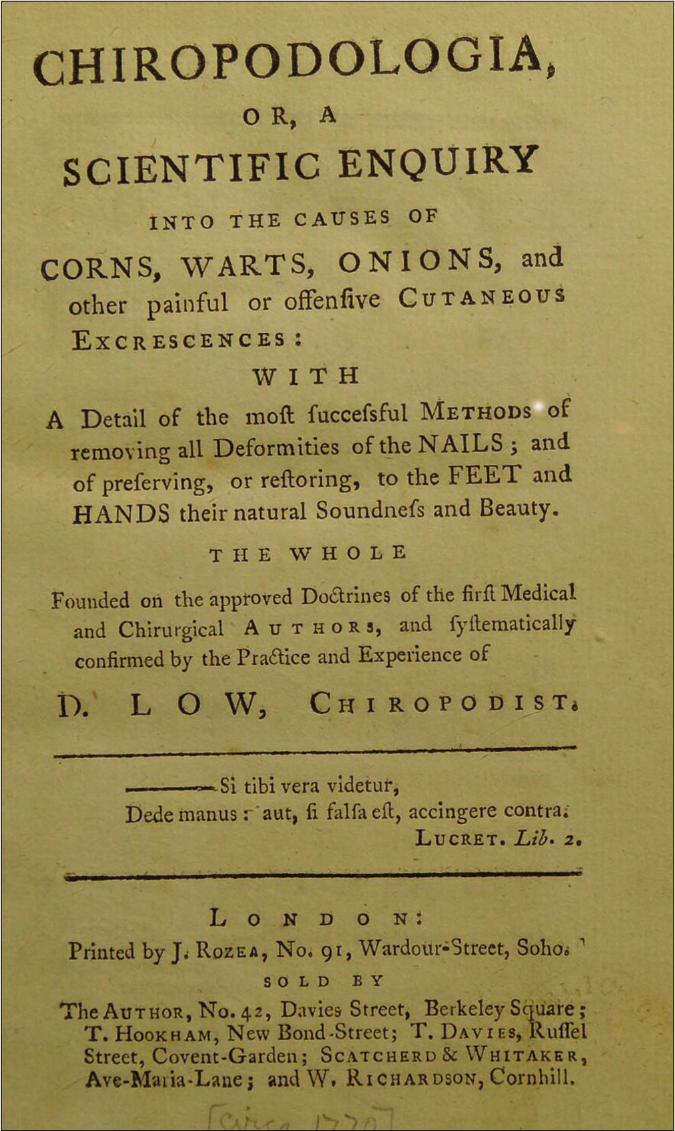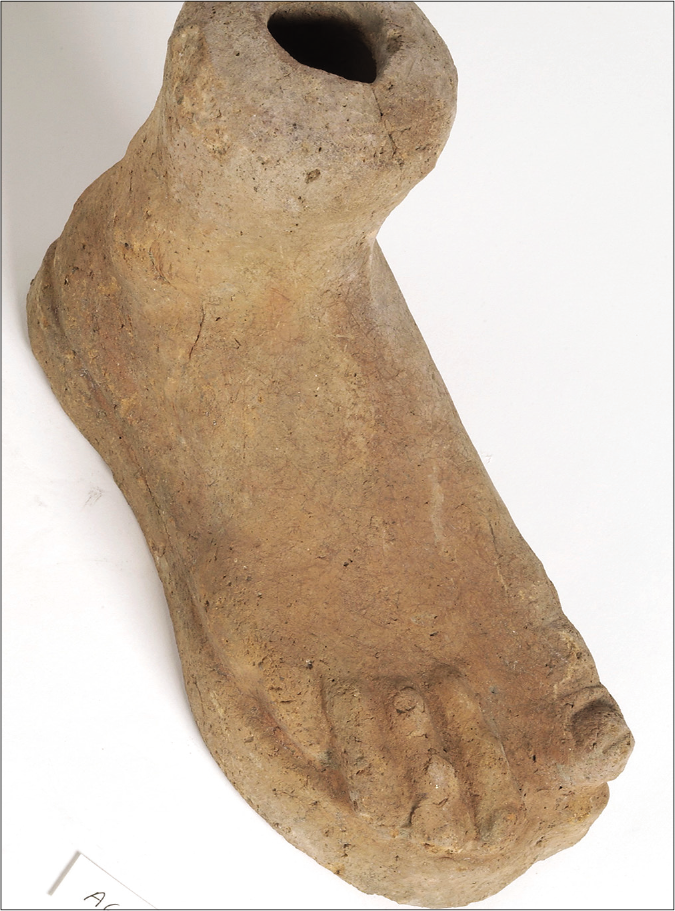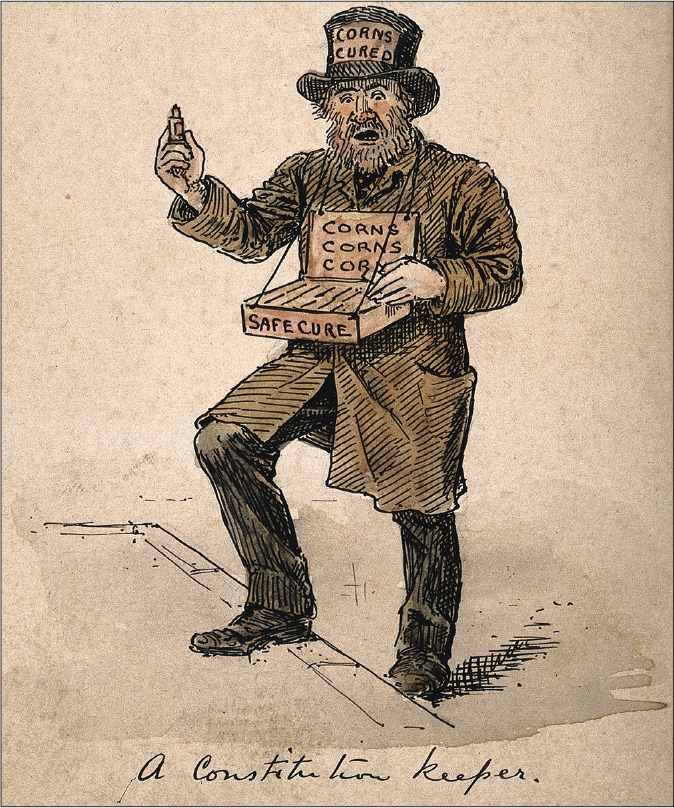Translate this page into:
Foot that hurts: A brief note on the history of corns and calluses
Corresponding author: Dr. Amiya Kumar Mukhopadhyay, “Pranab”, Ismile (Near Dharmaraj Mandir), Asansol, West Barddhaman, West Bengal, India. amiya64@gmail.com
-
Received: ,
Accepted: ,
How to cite this article: Mukhopadhyay AK. Foot that hurts: A brief note on the history of corns and calluses. Indian J Dermatol Venereol Leprol 2021;87:885-9.
Introduction
Capulet: Welcome, gentlemen. Ladies that have their toes Unplagued with corns will have a bout with you. Ah ha, my mistresses, which of you all Will now deny to dance? She that makes dainty, She I’ll swear hath corns. Am I come near ye now?
Romeo and Juliet, Act I, Scene v.
The great hall of the magnanimous host Capulet is busy with the last lap of preparation of the grand feast. An ostentatious party is about to start. The musicians are ready to play the tunes. Capulate is alluring gentlemen to dance with the beautiful ladies…. Who of the ladies would miss a chance? Nothing could restrain them, only except someone with those tiny devils on her feet --- the corns!
Since the antiquity, corns and callosities were a common place but attracted least attention. But when painful, it not only spoils a gorgeous party but the very walking of bipeds. The pain and agony are such that it had caught the attention of healers since the early days of medical history and since then a host of empirical remedies began its journey which ultimately culminated into the evolution of the subject of chiropody or podiatry.
The Nomenclature Dilemma
Before we embark on any discourse about the historical aspect of corns, it is prudent to take a look at the cloud of confusions hovering around the terminology. Skin confronts regular mechanical stress, resulting in hyperkeratinization. Some animals and humans except infants, are liable to develop a hyperkeratotic protective layers.1,2 These are variously named as corns, callus, callosity, clavum, heloma, tyloma, keratoma, etc.3 The word corns (Latin: Cornū), calluses (Latin: Callositas), and clavum (Latin: Callus, a variant of Callum) is derived from Latin, or Proto Indo- European languages.4-6 Corns are also known as heloma and calluses as tyloma. Both these words originate from Greek. The famous encyclopedist Aulus Cornelius Celsus (25 BC-AD 50), probably coined the term ‘corn’.7 These entities have some differences as described in the medical literature.8,9 In this article, the commonly used term “corns and callosities” will stand for these ailments and will be used henceforth.
Corns and Callosities: Why it Became Important
Many animals develop corns secondary to friction at different parts of the body, but seldom catch the attention of the medical world as they usually do not cause any significant problem. In case of human being corns provide both protection and pain. During the process of human evolution bipedalism added to the mobility, keeping hands free for other activities and giving the extra height in erect posture to get a better view towards preys and predators which helped early hunters and gatherers.10 But all these evolved with a price. Various problems of the weight bearing arose affecting different parts of the body, particularly feet. Corns and callosities developed to render protection to the feet, at times gives rise to pain and consequently limping. It further worsened when ill-fitting footwear were used. Various studies have shown a higher prevalence of these disorders in females. The reasons of these hyperkeratotic conditions ranged from barefoot walking, removal of shoes for religious reasons, trauma during ballet dancing to wearing of faulty footwear.11-14 Although the Chinese foot binding has been marked as infamous act of making ones feet painfully “beautiful,” the use of stiletto heels with narrow and pointed shoes — a fashion not too old in the Western world is equally responsible for corns and calluses in ladies.15
It can be assumed that this pain, difficulty in walking attracted attention of the early hominids and they must have learnt some way to take care of their feet though we do not have any evidence.16 The earliest indication of foot care is available at the entrance of the tomb of Ankmahor (2400 BC). This foot care might have included the care of the corns and calluses along with foot massage.7
Corns in the Old Medical Literature
Corns and calluses have found a place in medical literature since early days of recorded history. The earliest known mention of corns and their remedies can be seen in Papyrus Ebers (c. 1552 BC) which prescribed poultice of various berries cooked in cow-fat in the chapter on the diseases of the limbs.17,18 Hippocrates (460BC – 470BC) stressed on the physical removal of hard skin and invented instruments to scrape corns. Although there is controversy about the authenticity of authorship, it is said that a book on Cosmetics was written by Cleopatra VII Philopater (69BC–30BC), the last active Pharaoh in the Ptolamaic dynasty of ancient Egypt where she has mentioned about corns.1,19 Aulus Cornelius Celsus (25BC-AD10) in the Chapter XXVIII, Book V of his De Medicina prescribed paring of the corn along with application of medicament containing powder of milestone mixed with resin.20 Pliny the Elder (AD 23-79) in the chapter 62 (16) of Book XXVIII entitled: Remedies for gout and for diseases of the feet in his Natural History suggested treatment of corn with beef suet and powdered frankincense.21 Galen (c. AD 130–200) of Pergamum influenced the Western medicine for more than one and half millennia. He prescribed a mixture of crushed beetles, that is, cantharides and arsenic for the eradication of corns.22 The most famous medical authority Paulus Aegineta (AD 615-690) of the medieval era of the Western world in his Book III, Chapter LXXXI advocated management of corns and callosities by paring with scalpel or by rubbing with pumice stone. He also suggested cantharides, copperas, castor in equal parts mixed with turpentine; ashes of unripe lupines mixed with honey, sulfate of iron added to liquid pitch with the urine of boy who is yet to attend puberty, or beans boiled with vinegar. In a commentary of the same book Adams mentioned that Avicenna (A.D. c.980-1037), the most significant physician of the Islamic Golden Era mentioned about corns and opined that when the disease was not cured it may turn malignant. He prescribed Orchis maculata for pain management in corn. Rhazes (AD 854-AD 915), the famous Persian polymath and an important towering personality in the history of medicines prescribed an application composed of red arsenic, quicksilver killed ('killing' of quicksilver was an alchemic procedure used to process mercury), quick lime with ashes of acorns and oil. He also suggested cantharides and arsenic combination for corns. For callus he recommended juice of figs and spurge.23-25
If we turn our eyes from occidental to oriental history of medicine, China’s most intriguing and painful ancient tradition of foot binding that started in 10th century and continued till 1911 can be a perfect example of pressure and friction induced corns and callosities.26
The science of life or Ayurveda is ancient Indian system of medicine originated long before Christian era. Susruta Samhita (mid 1st millennium BC), one of the most important treatises of Ayurveda described the clinical picture of kadara (corns and calluses) in Nidansthanam of Kshudraroga Chapter (13.31) as lesions with central core with knotted and hard core. It may be elevated or depressed at center, painful and may be associated with discharge. The management of the lesions has been described in the Chkitsastahana (12.10) of the same treatise as excision, followed by thermal cautery and application of oil.27 Thus, it is very much perceptible that corns and calluses attracted attention of medical persons of all ancient civilizations and excision,cautery and/or topical application were evolved as the treatment of choice.
Old Literature, Specifically on Corns and Callosities
Till the renaissance of the Western world covering 15th and 16th centuries, corns and callosities were provided only few lines or paragraphs in the general medical and surgical treatises. The literature on foot care, in which management of corns and calluses was the central theme started with the publication of a French work entitled “L’Art de Soignre les Pieds” by Nicholas-Laurent La Forest in 1781 [Figure 1]. This work went unnoticed till 1785 when David Low published his work under a title of “Chiropodologia” [Figure 2]. Later it was found that Low copiously replicated the work of La Forest. However, this initiated the journey of literature on foot care and a new branch called “Chiropody.” A book on corns, bunion and nail disorder by an old army surgeon was published in 1800 and Hyman Lion, in 1802 wrote a book on these conditions but in 1845 it was Lewis Durlacher who first wrote a book on foot care which in true sense was a complete text on the subject. Various other treatises such as those of Ashton (1852), Adolphus (1865) and Freeland (1905) were published subsequently.28-30 Many booklets on specifications and instructions for stepwise application of the cure were available during the later part of the nineteenth century.

- Title page from La Forest, L'art de soigner les pieds. (Credit: Wellcome Library, London. Creative Commons Attribution only license CC BY 4.0 http://creativecommons.org/licenses/by/4.0/)

- Title page from D. Low, Chiropodologia. (Credit: Work available under Creative Commons Attribution only license CC BY 1.0 https://creativecommons.org/publicdomain/mark/1.0)
Corns: The Other History
The entity of corns and callosities have left their footprint in every walk of life breaking boundaries among countries, cultures, classes, socio-economic conditions and even emerge as a result of religious rituals.31-33 In ancient period of temple medicine, votives of foot were offered to the temples of various gods mainly to the Goddess Diana in Roman empire for healing. Many such foot votives showing corns and calluses have been recovered [Figure 3].34 Afterward, with the emergence of rational medicine the task was shifted from the priest healer to medical men. In medieval era corn-cutters became prevalent to take care of the responsibility. The engagement of personal corn-cutter became a mark of aristocracy in the 18th century. Thus, John Hardman became a man of fame as he was a personal chiropodist to the King William of Orange in early 18th century. Durlacher remained in the service to George IV, William V and Queen Victoria. The King of France had personal chiropodist to take care of corns. Napoleon had personal chiropodist too.7 The most accomplished corn-cutter in the history was Isachar Zacharie, the chiropodist to the American President Abraham Lincoln who was also given the responsibility of some political affairs of America.35

- A clay-baked foot. Roman votive offering. (Credit: Wellcome Collection. Attribution 4.0 International (CC BY 4.0) https://creativecommons.org/licences/by/4.0)
As about the history regarding the treatment, various modes of management was in use since early days as outlined earlier in this article. In 1518, during the reign of King Henry VII, the “Quack Charter” was introduced which controlled the quackery in England.36 This led to the emergence of various home remedies of various diseases including those for corns and callosities [Figure 4]. Street vendors selling their corn remedy were a frequent scene [Figure 5]. From Hindley’s “A History of the cries of London,” we see corn cutters are advertising loudly about their business in eighteenth and nineteenth century London streets.37 Different companies advertised their goods for attracting people suffering from these ailments [Figure 6]. Although with the development of modern medical system these practices have become a story of the past, some vestiges are still there.38

- Cutting corns: Colored lithograph after J. Gillray. (Credit: Wellcome Collection. Attribution 4.0 International (CC BY 4.0) https://creativecommons.org/licences/by/4.0)

- An itinerant street vendor selling cures for corns. (Credit: Wellcome Collection. Attribution 4.0 International (CC BY 4.0) https://creativecommons.org/licences/by/4.0)

- Hodgson’s genuine patent medicines. German corn plaster. (Wellcome collection. Credit: https://creativecommons.org/publicdomain/mark/1.0)
Foot That Hurts…
With the bipedalism the corns and callosities have added an almost unavoidable ailment in our inventory of sufferings.
The erect posture rendered priority and prosperity. Corns and calluses formed to provide protection from friction induced wear and tear, but with the payment of premium for pain and agony in every footstep. Although dermatologists often confront these problems, never felt it notable due to the magnitude of familiarity. The management has evolved mostly as a result of trial and error. There is little curiosity for searching the history and evolution of these entities. Corns and calluses are considered common and trivial, but is a painful corn impediment for a dance in a grand celebration only, not for an effortless daily life? Is that pain of a corn limited to a foot only? Nay! With every stride it affects the person as a whole instead and hence it is imperative for a physician to know the history and evolution of corns and callosities and their management to find out ways to save not only the ailing feet, but a person as a whole, for “When our feet hurt, we hurt allover” (Socrates).
Declaration of patient consent
Patient’s consent not required as there are no patients in this study.
Financial support and sponsorship
Nil.
Conflicts of interest
There are no conflicts of interest.
References
- Corns and calluses In: Goldsmith LA, Katz SI, Gilchrest BA, Paller A, Leffel DJ, Wolff K, eds. Fitzpatrick's Dermatology in General Medicine (8th ed). New York: McGraw-Hill; 2012. p. :1111-4.
- [Google Scholar]
- Corns and calluses resulting from mechanical hyperkeratosis. Am Fam Physician. 2002;65:2277-80.
- [Google Scholar]
- Environmental and sports related skin diseases In: Bolognia JL, Jorizzo JL, Schaffer JV, eds. Dermatology (3rd ed). New Delhi: Saunders; 2012. p. :1501.
- [Google Scholar]
- Anonymous. Available from: https://www.merriam-webster.com/dictionary [Last accessed on 2020 Jul 08]
- [Google Scholar]
- Anonymous. Available from: https://www.lexico.com/definition/callosity [Last accessed on 2020 Jul 08]
- [Google Scholar]
- Anonymous. Available from: https://www.wordsens.eu/clavum [Last accessed on 2020 Sep 08]
- [Google Scholar]
- A Brief History of Chiropody and Podiatry. 2020. Available from: https://www.johnpearson.wordpress.com/2015/01/18/a-brief-history-of-chiropody-and-podiatry [Last accessed on 2020 Sep 01]
- [Google Scholar]
- Australopithecus Africanus: The man-ape of South Africa. Nature. 1925;115:195-9.
- [CrossRef] [Google Scholar]
- Foot problem in the US: The 1990 health interview survey. J Am Podiatr Med Assoc. 1993;83:475-83.
- [CrossRef] [PubMed] [Google Scholar]
- A survey to investigate the association of pain, disability and quality of life with corns. J Am Foot Ankle Res. 2015;8:70-6.
- [CrossRef] [PubMed] [Google Scholar]
- Prevalence of ankle and foot conditions in a multiethnic community sample of older adults. Am J Epidemiol. 2004;159:491-8.
- [CrossRef] [PubMed] [Google Scholar]
- The foot in ballet dancers: The importance of second toe length. Foot Ankle Int. 1995;16:144-17.
- [CrossRef] [PubMed] [Google Scholar]
- Female foot deformation in modern Europe and ancient China. J Coll Gen Pract. 1965;9:175-9.
- [Google Scholar]
- The Medical Features of the Papyrus Ebers Chicago: Press of the American Medical Association; 1905. p. :9.
- [Google Scholar]
- Ancient Egyptian Medicine: The Papyrus Ebers Chicago: Ares Publishers Inc.; 1930. p. :63.
- [Google Scholar]
- Of Medicine (English translation from Latin English by Grieve J) Edinburgh: Dickinson and Co; 1814. p. :255.
- [Google Scholar]
- Corns and Cow Dung: What's the Story? 2020. Available from: https://www.theshoeman647325124.wordpress.com/2018/09/04/corns-and-cow-dung-whats-the-story [Last accessed on 2020 Sep 20]
- [Google Scholar]
- Avicenna's canon of medicine: A review of analgesics and anti-inflammatory substances. Avicenna J Phytomed. 2015;5:182-202.
- [Google Scholar]
- A treatise on Corns, Bunions and in Growing of Toe Nail: Their Cause and Management London: John Churchill; 1852.
- [Google Scholar]
- A Concise Treatise on the Disorders of the Human Foot, Corns, Bunions and Diseased Nails London: Mr. Mitchell, Book Sellers and Publishers; 1865.
- [Google Scholar]
- The Radical Cure of Corns and Bunions London: John Bale, Sons and Danielsson Ltd.; 1905.
- [Google Scholar]
- Callosities of cross-legged sitting: “Yoga sign”-an under-recognized cultural cutaneous presentation. Int J Dermatol. 2008;47:1212-4.
- [CrossRef] [PubMed] [Google Scholar]
- Isachar Zacharie: Lincoln's Chiropodist. Vol 43. United States: American Jewish Historical Society; 1953. p. :71-126.
- [Google Scholar]
- 500 Years of the Royal College of Physicians. 2020. Available from: https://www.thehistorypress.co.uk/articles/500-years-of-the-royal-college-of-physicians [Last accessed on 2020 Oct 12]
- [Google Scholar]
- They all Come Crying but Leave with a Smile. 2020. Available from: https://www.indianexpress.com/article/cities/mumbai/they-all-come-crying-but-leave-with-a-smile-corn-calluses-mumbai-footpath-healer-4673995 [Last accessed on 2020 Oct 11]
- [Google Scholar]





